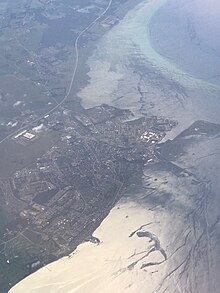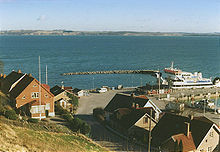Landskrona Municipality
Landskrona Municipality
Landskrona kommun | |
|---|---|
 Landskrona Town Hall | |
 Coat of arms | |
 | |
| Coordinates: 55°52′N 12°50′E / 55.867°N 12.833°ECoordinates: 55°52′N 12°50′E / 55.867°N 12.833°E | |
| Country | Sweden |
| County | Scania County |
| Seat | Landskrona |
| Area | |
| • Total | 300.64 km2 (116.08 sq mi) |
| • Land | 140.28 km2 (54.16 sq mi) |
| • Water | 160.36 km2 (61.92 sq mi) |
| Area as of 1 January 2014. | |
| Population (31 December 2019)[2] | |
| • Total | 46,090 |
| • Density | 150/km2 (400/sq mi) |
| Time zone | UTC+1 (CET) |
| • Summer (DST) | UTC+2 (CEST) |
| ISO 3166 code | SE |
| Province | Scania |
| Municipal code | 1282 |
| Website | www.landskrona.se |
Landskrona Municipality (Landskrona kommun) is a municipality in Scania County in Sweden. Its seat is located in the city of Landskrona.
The island of Ven was added to the City of Landskrona in 1959. The amalgamations leading to the present municipality took place in 1967, 1969 and 1974. Since 1971 it is a municipality of unitary type, like all other municipalities of Sweden. The municipality, however, prefers to style itself Landskrona stad (City of Landskrona). This is purely nominal and has no effect on the status of the municipality.
Localities[]

There are 8 urban areas (also called a Tätort or locality) in Landskrona Municipality. In the table they are listed according to the size of the population as of December 31, 2005. The municipal seat is in bold characters.
| # | Locality | Population |
|---|---|---|
| 1 | Landskrona | 28,670 |
| 2 | Häljarp | 2,561 |
| 3 | Glumslöv | 1,861 |
| 4 | Asmundtorp | 1,551 |
| 5 | Saxtorpsskogen | 729 |
| 6 | Härslöv | 401 |
| 7 | Annelöv | 341 |
| 8 | Kvärlöv | 206 |


Elections[]
Below are the results since the 1973 municipal reform listed. Between 1988 and 1998 the Sweden Democrats' results were not published by the SCB due to the party's small size nationwide. "Turnout" denotes the percentage of the electorate casting a ballot, but "Votes" only applies to valid ballots cast.
Riksdag[]
| Year | Turnout | Votes | V | S | MP | C | L | KD | M | SD | ND |
|---|---|---|---|---|---|---|---|---|---|---|---|
| 1973[3] | 92.1 | 24,196 | 2.4 | 57.9 | 0.0 | 18.5 | 6.5 | 0.8 | 13.7 | 0.0 | 0.0 |
| 1976[4] | 92.2 | 24,899 | 2.2 | 55.3 | 0.0 | 15.5 | 9.4 | 0.8 | 16.5 | 0.0 | 0.0 |
| 1979[5] | 91.3 | 24,306 | 2.8 | 54.6 | 0.0 | 8.8 | 9.7 | 0.5 | 22.7 | 0.0 | 0.0 |
| 1982[6] | 92.0 | 24,245 | 3.4 | 56.3 | 1.3 | 7.8 | 4.9 | 0.5 | 25.5 | 0.0 | 0.0 |
| 1985[7] | 90.0 | 23,758 | 3.4 | 54.9 | 1.2 | 5.3 | 10.5 | 0.0 | 24.4 | 0.0 | 0.0 |
| 1988[8] | 86.0 | 22,653 | 3.7 | 53.0 | 5.0 | 5.3 | 9.2 | 0.9 | 22.0 | 0.0 | 0.0 |
| 1991[9] | 85.9 | 22,912 | 3.0 | 45.3 | 2.0 | 4.4 | 6.6 | 4.2 | 26.3 | 0.0 | 6.0 |
| 1994[10] | 86.9 | 23,145 | 3.6 | 56.3 | 3.1 | 3.4 | 4.5 | 1.6 | 24.5 | 0.0 | 2.0 |
| 1998[11] | 79.6 | 21,183 | 8.2 | 43.9 | 2.9 | 2.1 | 3.8 | 6.6 | 25.0 | 0.0 | 0.0 |
| 2002[12] | 77.0 | 21,382 | 6.3 | 44.3 | 2.5 | 2.1 | 13.5 | 5.7 | 16.4 | 6.2 | 0.0 |
| 2006[13] | 80.0 | 23,056 | 3.9 | 40.8 | 2.9 | 3.0 | 12.2 | 2.8 | 24.2 | 8.2 | 0.0 |
| 2010[14] | 81.8 | 24,361 | 4.1 | 35.8 | 4.3 | 2.5 | 11.7 | 2.5 | 28.2 | 9.9 | 0.0 |
| 2014[15] | 81.9 | 25,354 | 4.2 | 37.3 | 5.0 | 2.8 | 7.0 | 2.0 | 19.9 | 18.8 | 0.0 |
Blocs
This lists the relative strength of the socialist and centre-right blocs since 1973, but parties not elected to the Riksdag are inserted as "other", including the Sweden Democrats results from 1988 to 2006, but also the Christian Democrats pre-1991 and the Greens in 1982, 1985 and 1991. The sources are identical to the table above. The coalition or government mandate marked in bold formed the government after the election. New Democracy got elected in 1991 but are still listed as "other" due to the short lifespan of the party. "Elected" is the total number of percentage points from the municipality that went to parties who were elected to the Riksdag.
| Year | Turnout | Votes | Left | Right | SD | Other | Elected |
|---|---|---|---|---|---|---|---|
| 1973 | 92.1 | 24,196 | 60.3 | 38.7 | 0.0 | 1.0 | 99.0 |
| 1976 | 92.2 | 24,899 | 57.5 | 41.4 | 0.0 | 1.1 | 98.9 |
| 1979 | 91.3 | 24,306 | 57.4 | 41.2 | 0.0 | 1.4 | 98.6 |
| 1982 | 92.0 | 24,245 | 59.7 | 38.2 | 0.0 | 2.1 | 97.9 |
| 1985 | 90.0 | 23,758 | 58.3 | 40.2 | 0.0 | 1.5 | 98.5 |
| 1988 | 86.0 | 22,653 | 61.7 | 36.5 | 0.0 | 1.8 | 98.2 |
| 1991 | 85.9 | 22,912 | 48.3 | 41.5 | 0.0 | 10.2 | 95.8 |
| 1994 | 86.9 | 23,145 | 63.0 | 34.0 | 0.0 | 3.0 | 97.0 |
| 1998 | 79.6 | 21,183 | 55.0 | 37.5 | 0.0 | 7.5 | 92.5 |
| 2002 | 77.0 | 21,382 | 53.1 | 37.7 | 0.0 | 9.2 | 90.8 |
| 2006 | 80.0 | 23,056 | 47.6 | 42.2 | 0.0 | 10.2 | 89.8 |
| 2010 | 81.8 | 24,361 | 44.2 | 44.9 | 9.9 | 1.0 | 99.0 |
| 2014 | 81.9 | 25,354 | 46.5 | 31.7 | 18.8 | 3.0 | 97.0 |
International relations[]
Twin towns — Sister cities[]
The municipality is twinned with:[16]
See also[]
References[]
- ^ "Statistiska centralbyrån, Kommunarealer den 1 januari 2014" (in Swedish). Statistics Sweden. 2014-01-01. Archived from the original (Microsoft Excel) on 2016-09-27. Retrieved 2014-04-18.
- ^ "Folkmängd i riket, län och kommuner 31 december 2019" (in Swedish). Statistics Sweden. February 20, 2020. Retrieved February 20, 2020.
- ^ "Riksdagsvalet 1973 (page 164)" (PDF) (in Swedish). SCB. Retrieved 8 September 2017.
- ^ "Riksdagsvalet 1976 (page 158)" (PDF) (in Swedish). SCB. Retrieved 8 September 2017.
- ^ "Riksdagsvalet 1979 (page 183)" (PDF) (in Swedish). SCB. Retrieved 8 September 2017.
- ^ "Riksdagsvalet 1982 (page 184)" (PDF) (in Swedish). SCB. Retrieved 8 September 2017.
- ^ "Riksdagsvalet 1985 (page 185" (PDF) (in Swedish). SCB. Retrieved 8 September 2017.
- ^ "Riksdagsvalet 1988 (page 165)" (PDF) (in Swedish). SCB. Retrieved 8 September 2017.
- ^ "Riksdagsvalet 1991 (page 26)" (PDF) (in Swedish). SCB. Retrieved 8 September 2017.
- ^ "Riksdagsvalet 1994 (page 40)" (PDF) (in Swedish). SCB. Retrieved 8 September 2017.
- ^ "Riksdagsvalet 1998 (page 36)" (PDF) (in Swedish). SCB. Retrieved 8 September 2017.
- ^ "Valresultat Riksdag Landskrona kommun 2002" (in Swedish). Valmyndigheten. Retrieved 8 September 2017.
- ^ "Valresultat Riksdag Landskrona kommun 2006" (in Swedish). Valmyndigheten. Retrieved 8 September 2017.
- ^ "Valresultat Riksdag Landskrona kommun 2010" (in Swedish). Valmyndigheten. Retrieved 10 September 2017.
- ^ "Valresultat Riksdag Landskrona kommun 2014" (in Swedish). Valmyndigheten. Retrieved 10 September 2017.
- ^ "Vänorter" (in Swedish). Landskrona Municipality. 2017-10-04.
External links[]
| Wikimedia Commons has media related to Landskrona Municipality. |
- Landskrona Municipality - Official site
- Municipalities of Skåne County
- Landskrona
